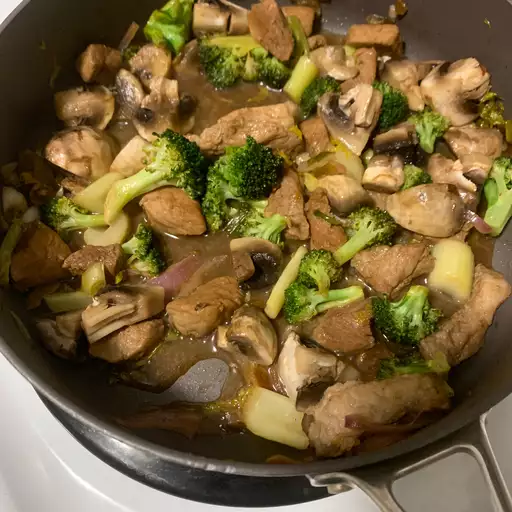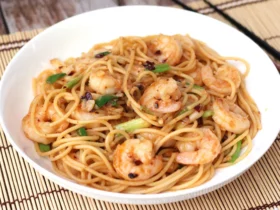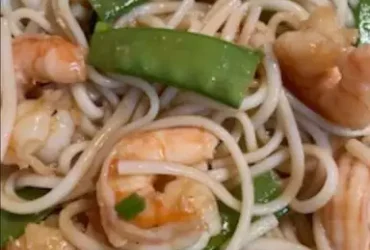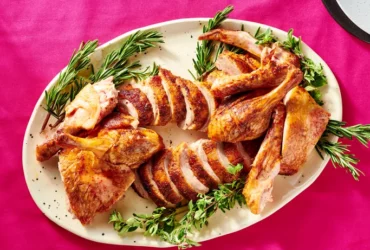Background and History
Stir-fry pork with ginger is a classic dish in Asian cuisine, particularly in Chinese and Thai cooking. This dish combines tender slices of pork with the zingy, aromatic flavor of fresh ginger. It’s a quick and flavorful meal that’s been enjoyed for generations, celebrated for its simplicity and depth of flavor. The method of stir-frying dates back over 2,000 years in China and has become a popular cooking technique worldwide for its ability to cook ingredients quickly while preserving their texture and nutritional value.

Serves: 4
Time: 10 minutes
Cooking Time: 15 minutes
Ingredients
- 1 lb (450g) pork tenderloin, thinly sliced
- 2 tablespoons vegetable oil
- 2-inch piece of fresh ginger, peeled and thinly sliced
- 3 garlic cloves, minced
- 1 medium onion, thinly sliced
- 1 bell pepper (any color), sliced
- 2 tablespoons soy sauce
- 1 tablespoon oyster sauce
- 1 teaspoon sugar
- 1/2 cup chicken broth or water
- 2 green onions, chopped
- Cooked rice, for serving
Instructions
- Prepare the Ingredients:
- Thinly slice the pork tenderloin.
- Peel and thinly slice the ginger.
- Mince the garlic.
Thinly slice the onion and bell pepper
- Chop the green onions.
- Marinate the Pork:
- In a bowl, combine the pork slices with 1 tablespoon of soy sauce. Let it marinate for about 10 minutes while you prepare the other ingredients.
Heat the Oil
In a large wok or skillet, heat the vegetable oil over medium-high heat.
Cook the Ginger and Garlic
- Add the sliced ginger and minced garlic to the wok. Stir-fry for about 1 minute until fragrant.
Add the Pork
- Increase the heat to high and add the marinated pork slices. Stir-fry for 3-4 minutes until the pork is browned and cooked through.
- Stir-fry the Vegetables:
- Add the sliced onion and bell pepper to the wok. Continue to stir-fry for another 2-3 minutes until the vegetables are tender-crisp.
Add Sauces and Broth
- Pour in the remaining soy sauce, oyster sauce, sugar, and chicken broth (or water). Stir everything together and let it cook for an additional 2 minutes until the sauce slightly thickens.
Finish with Green Onions
- Sprinkle the chopped green onions over the stir-fry. Give it a final stir to combine.
Serve
Serve the stir-fry pork with ginger over cooked rice.
Nutrition Facts (per serving)
- Calories: 290
- Protein: 25g
- Carbohydrates: 12g
- Fat: 16g
- Fiber: 2g
- Sugar: 4g
- Sodium: 820mg
Notes
- Variations: You can add other vegetables such as broccoli, snap peas, or carrots to the stir-fry for added nutrition and color.
- Spice Level: If you prefer a spicier dish, add a sliced chili pepper or a teaspoon of chili paste when cooking the ginger and garlic.
- Ginger: Fresh ginger is key to the dish’s flavor. Powdered ginger can be used in a pinch but won’t provide the same fresh, vibrant taste.
Allergy Warning
- Soy Sauce: Contains soy and gluten. Use tamari for a gluten-free option.
- Oyster Sauce: Contains shellfish. There are vegetarian versions available if needed.
- Cross-Contamination: Be cautious of cross-contamination if preparing for someone with food allergies. Ensure all utensils and cooking surfaces are clean.
- Best Lusha Alternatives for 2025 - April 22, 2025
- Best Overloop Alternatives for 2025 - April 22, 2025
- Best 6sense Alternatives for 2025 - April 22, 2025














